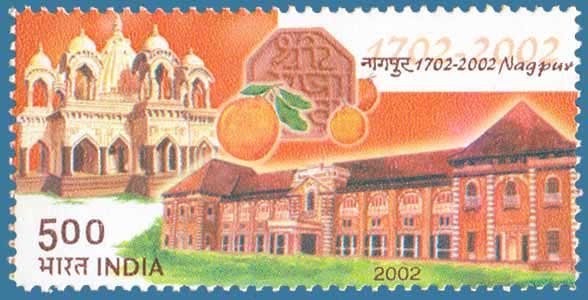300th Anniversary of Nagpur

Technical Data
| Date of Issue | November 11, 2002 |
|---|---|
| Denomination | Rs. 5 |
| Perforation | comb 13 |
| Printer | Security Printing Press, Nashik |
| Watermark | No Watermark |
| Colors | Multicolor |
| Catalog Codes |
Michel IN 1929 Stamp Number IN 1981 Yvert et Tellier IN 1694 Stanley Gibbons IN 2096 WADP Numbering System - WNS IN040.02 |
| Themes | Anniversaries and Jubilees | Buildings | Government Buildings | Temples |
Table of Contents
Nagpur: A Commemorative Overview
Historical Significance and Development
- Founding: Nagpur was founded in 1702 by Bakht Buland Shah, who integrated twelve small hamlets, including Rajapur and Barsa, to establish a new settlement.
- Early Identity: The city’s origins trace back to around 2500 B.C., with references to it in ancient texts as a thriving urban center.
- Medieval Period: During the medieval era, Nagpur’s development was influenced by various rulers. Bhakt Buland, the Gond King, was inspired by Delhi to build Nagpur as his capital. His successor, Chand Sultan, continued the expansion.
- Bhonsala Rule: The Bhonsalas, who took control in 1742, contributed to the city’s growth by promoting agriculture, industry, and cultural activities.
Colonial Era and British Influence
- British Rule: In the mid-19th century, Nagpur fell under British control. The city was transformed into a commercial hub for agricultural and forest produce and became the capital of Central Province & Berar.
- Economic Impact: The integration into the colonial economy led to significant infrastructural changes, including new road and rail links. However, this also disrupted the city’s socio-cultural environment.
Post-Independence and Modern Era
- State Reorganization: Following India’s independence, Nagpur was incorporated into Maharashtra and became the state’s second capital.
- Urban Growth: Over the past fifty years, Nagpur has experienced rapid growth, becoming one of India’s major urban centers. This growth has brought challenges related to infrastructure and ecology, which are being addressed by various government and community efforts.
- Industrial Base: Nagpur’s economy is diversified, with industries such as ferromanganese products, metal goods, cotton processing, ginning, and paint manufacturing.
Modern Identity
- Geographical Significance: Located at the geographical center of India, Nagpur boasts excellent connectivity through road, rail, and air.
- Environmental Management: The city is known for its efforts in environmental conservation and is considered one of the greenest cities in India.
- Cultural and Economic Hub: With a cosmopolitan population and a blend of tradition and modernity, Nagpur represents a significant urban center in India.
Commemorative Stamp
- Design: The commemorative stamp celebrates the tercentenary of Nagpur. It features two landmarks:
- Vidhan Bhavan: The legislative building.
- Samadhi of Raghuji Bhonsle: A memorial dedicated to the Bhonsala ruler.
- Theme: The stamp highlights Nagpur’s identity as “The Orange City of India,” reflecting its prominence in orange cultivation.
- Sheetlet: The stamps are issued in a sheetlet that includes an artist’s impression of Bakht Buland and a collage of images related to Nagpur.
- First Day Cover: The cover features a collage showcasing various aspects of the city.
This commemorative stamp acknowledges Nagpur’s historical evolution, its role as a major urban center, and its contribution to India’s economic and cultural landscape.
